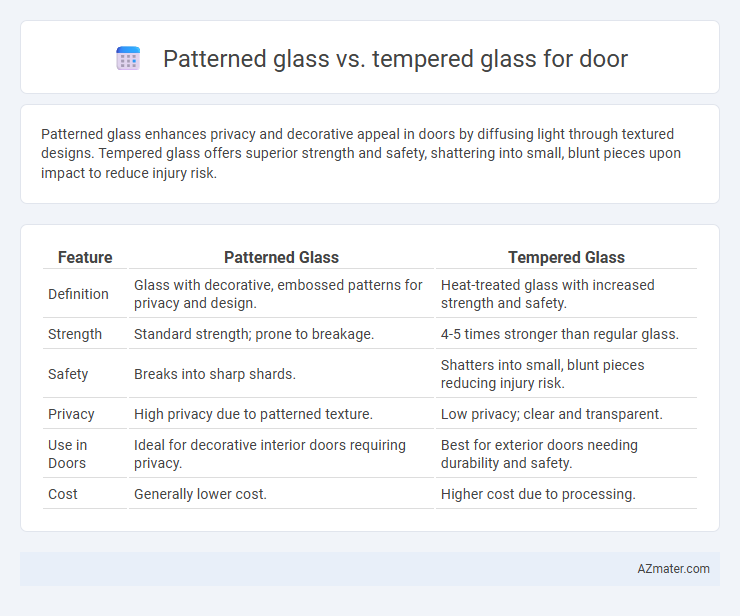Patterned glass enhances privacy and decorative appeal in doors by diffusing light through textured designs. Tempered glass offers superior strength and safety, shattering into small, blunt pieces upon impact to reduce injury risk.
Table of Comparison
| Feature | Patterned Glass | Tempered Glass |
|---|---|---|
| Definition | Glass with decorative, embossed patterns for privacy and design. | Heat-treated glass with increased strength and safety. |
| Strength | Standard strength; prone to breakage. | 4-5 times stronger than regular glass. |
| Safety | Breaks into sharp shards. | Shatters into small, blunt pieces reducing injury risk. |
| Privacy | High privacy due to patterned texture. | Low privacy; clear and transparent. |
| Use in Doors | Ideal for decorative interior doors requiring privacy. | Best for exterior doors needing durability and safety. |
| Cost | Generally lower cost. | Higher cost due to processing. |
Introduction to Patterned and Tempered Glass Doors
Patterned glass doors feature textured surfaces that enhance privacy while allowing light to pass through, making them ideal for both residential and commercial interiors. Tempered glass doors are manufactured through a heat-treatment process that increases strength and safety, ensuring greater resistance to impact and shattering. Combining aesthetics and functionality, patterned glass provides decorative appeal, whereas tempered glass offers superior durability and safety for door applications.
Key Features of Patterned Glass
Patterned glass for doors features distinctive textured surfaces that provide enhanced privacy while allowing natural light to pass through, making it ideal for decorative and functional applications. Its key characteristics include a variety of intricate designs that can obscure visibility without compromising brightness, and durability sufficient for typical door use but without the high impact resistance of tempered glass. Patterned glass is often chosen for aesthetic appeal and privacy in interior doors, whereas tempered glass offers superior strength and safety for exterior or high-traffic door installations.
Key Features of Tempered Glass
Tempered glass for doors offers enhanced strength and safety, being up to five times stronger than regular glass and designed to shatter into small, blunt pieces rather than sharp shards. It provides superior thermal resistance and impact durability, making it ideal for high-traffic or exterior door applications. Unlike patterned glass, which focuses on aesthetic privacy, tempered glass prioritizes safety compliance and structural integrity.
Visual Appeal: Patterned vs Tempered Glass
Patterned glass enhances visual appeal by offering decorative textures and designs that provide privacy while allowing light to pass through, making it ideal for aesthetic door applications. Tempered glass features a clear, smooth surface with high strength and safety, emphasizing a sleek, modern look without additional decorative elements. Choosing between patterned and tempered glass for doors depends on the desired combination of style, light diffusion, and safety requirements.
Safety and Durability Comparison
Tempered glass offers superior safety due to its heat-treated process, which makes it up to five times stronger than standard glass and causes it to shatter into small, blunt pieces rather than sharp shards. Patterned glass provides enhanced privacy and aesthetic appeal but lacks the same level of strength and impact resistance as tempered glass, making it less ideal for high-traffic or impact-prone door areas. When durability and safety are top priorities, tempered glass is the preferred choice for door installations requiring maximum protection and compliance with safety standards.
Privacy Considerations for Door Applications
Patterned glass offers enhanced privacy for door applications by obscuring visibility while allowing natural light to filter through, making it ideal for areas requiring both light and discretion. Tempered glass, though stronger and safer due to its shatter-resistant properties, is typically clear and less effective at providing privacy unless combined with additional treatments like frosting or films. Selecting between patterned and tempered glass hinges on balancing privacy needs with safety requirements, especially in residential or commercial door installations.
Cost Differences: Patterned vs Tempered Glass
Patterned glass typically costs less than tempered glass due to its simpler manufacturing process and standard thickness options, making it a budget-friendly choice for decorative door applications. Tempered glass demands higher production costs since it undergoes a heat treatment process to enhance strength and safety, which increases its price by 30% to 50% compared to patterned glass. Choosing between patterned and tempered glass for doors involves balancing aesthetic preferences against performance requirements and budget constraints.
Maintenance and Cleaning Requirements
Patterned glass for doors requires gentle cleaning with mild soap and water to avoid damaging the textured surface, while tempered glass offers a smooth finish that is easier to clean and more resistant to scratching. Tempered glass's durability reduces the need for frequent maintenance, whereas patterned glass may accumulate dirt in crevices, necessitating more detailed cleaning. Choosing tempered glass minimizes maintenance efforts due to its sturdy and smooth characteristics compared to the more delicate care needed with patterned glass.
Ideal Applications for Each Glass Type
Patterned glass is ideal for doors requiring privacy without sacrificing natural light, commonly used in interior doors, bathroom enclosures, and decorative applications. Tempered glass offers enhanced strength and safety features, making it suitable for exterior doors, sliding doors, and high-traffic areas where impact resistance and durability are essential. Choosing patterned glass enhances aesthetic appeal and obscures visibility, while tempered glass ensures safety compliance and structural integrity.
Choosing the Right Glass for Your Door
Patterned glass offers enhanced privacy and decorative appeal by diffusing light while obscuring visibility, making it ideal for entry doors requiring a balance of style and seclusion. Tempered glass provides superior strength and safety by undergoing a heat-treatment process that increases its resistance to breakage, suitable for doors in high-traffic or impact-prone areas. Selecting the right glass depends on your priorities--opt for patterned glass to maintain privacy with aesthetic design, or choose tempered glass for durability and enhanced safety performance.

Infographic: Patterned glass vs Tempered glass for Door
 azmater.com
azmater.com